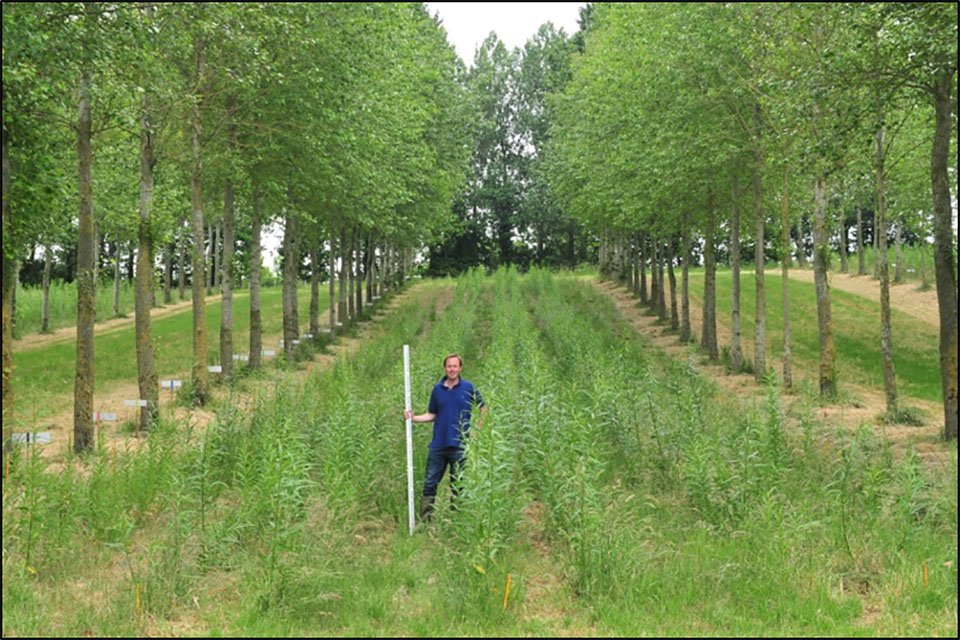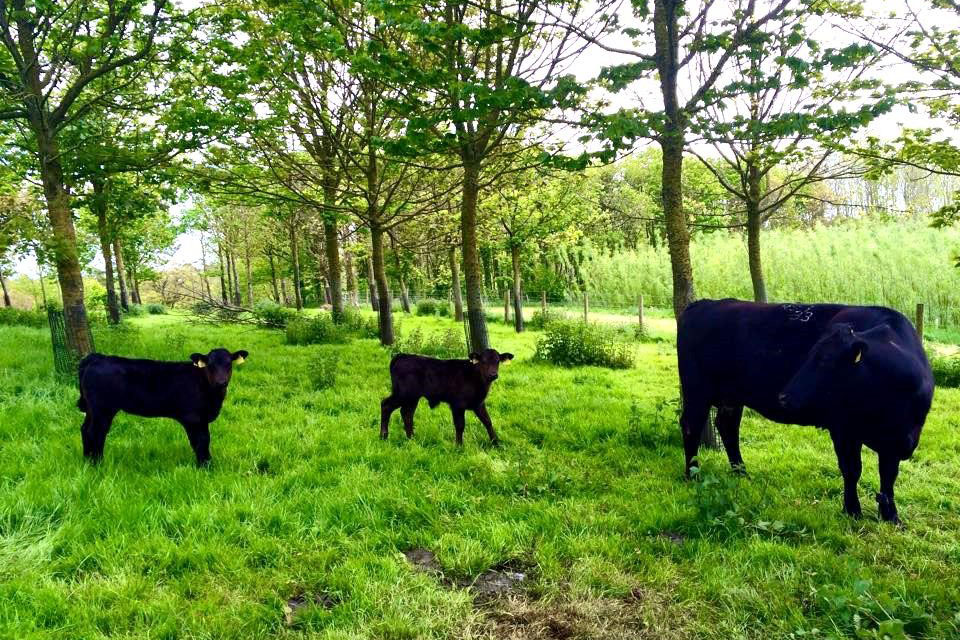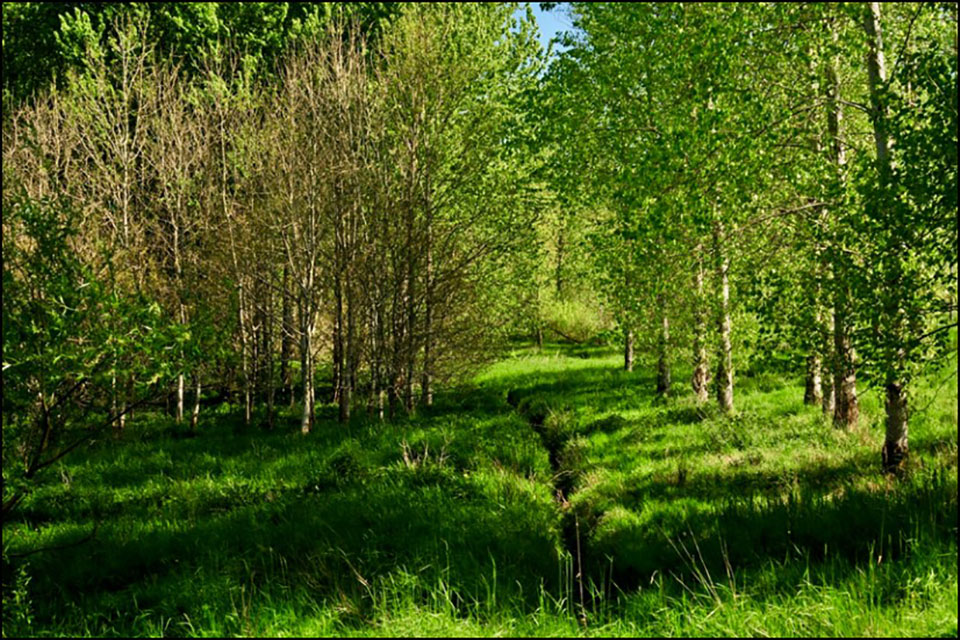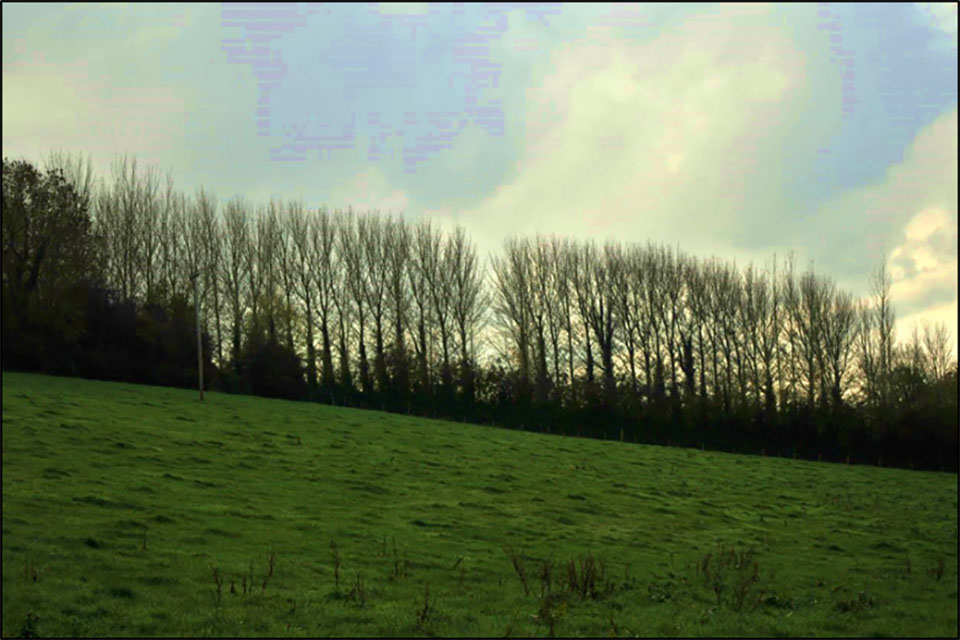Agroforestry and the Basic Payment Scheme
An explanation and examples of some agroforestry options that are compatible with the Basic Payment Scheme
Applies to England
Introduction
When the Basic Payment Scheme (BPS) was introduced, the Rural Payments Agency (RPA) stated that grazed woodland was no longer eligible for payment.
This has led to some confusion that BPS is not compatible with agroforestry systems. However, some forms of agroforestry are allowed by the scheme rules. As simplifications are being made to BPS, it’s a good time to clarify these rules, especially considering the environmental benefits of having trees on farms, the government commitment to planting new trees, and the desire to support agroforestry through land management schemes.
The benefits of agroforestry
Agroforestry is where trees are deliberately combined with agriculture on the same piece of land. It plays an important role in creating woodland on farms. It’s an essential bridge between agriculture and forestry, providing two potential sources of income to farmers:
- the agricultural products (livestock or crops)
- forestry-generated products (sawlogs, fuelwood, fruit and nuts)
This diversity will help reduce the risk from changes in the agricultural markets and help to stimulate and strengthen the rural economy.
Agroforestry also supports a number of goals in the government’s 25 Year Environment Plan and Clean Growth Strategy. It provides wider ecosystem services, such as increased production potential, soil conservation, carbon capture, improved livestock welfare and increased biodiversity, and habitat creation. Agroforestry can also play an important role in climate change mitigation and adaptation.
The Committee on Climate Change estimates that agroforestry, specifically
- silvoarable systems - where crops grow between trees
- silvopastoral systems - where farm animals graze between trees
- hedge creation,
could result in carbon emissions savings of 5.9 MtCO2e per year by 2050. This represents approximately 13% of the total current emissions from the agriculture sector. Research commissioned by Defra is also assessing the potential carbon savings from agroforestry.
The government is looking at a wide range of agroforestry practices including:
- silvopasture
- silvoarable
- riparian forest buffers
- windbreaks/shelterbelts
- forest farming (including orchards)
- hedgerows with standards
These practices are explained in more detail below. This range of agroforestry practices gives farmers flexibility with options and will ensure the environmental sustainability of agricultural land.
What the ‘Basic Payment Scheme: rules for 2022’ say
The scheme rules are clear that land growing some types of tree is eligible for BPS, however densely grown. In the sections and subsections
- ‘What land is eligible for BPS’
- ‘Permanent crops’
- ‘Short rotation coppice’
- ‘List of eligible crops’,
a number of tree varieties are clearly eligible. These trees could be used in agroforestry systems.
The scheme rules are also clear that land supporting any variety of tree can be eligible if certain conditions are met. The ‘List of Features’ includes the row ‘Trees’ which states:
‘Trees are eligible if they are:
- a) individual trees scattered within an agricultural parcel;
- b) lines of trees (of a maximum of two trees wide) on an agricultural parcel;
- c) groups of trees on an agricultural parcel that are not adjacent to a boundary; and
- I. the area underneath the canopy is used for agricultural activity (this condition is met where it is suitable for cultivation or grazing of livestock);
- II. more than 50% of the area underneath the tree canopy is covered by grasses, other herbaceous forage or arable land.
or
- d) groups of trees on an agricultural parcel that are adjacent to a boundary and;
- I. the area underneath the canopy is used for agricultural activity (this condition is met where it is suitable for cultivation or grazing of livestock);
- II. if unsuitable for cultivation, the entire area under the canopy is accessible to farm animals for grazing; and
- III. more than 50% of the area underneath the tree canopy is covered by grasses, other herbaceous forage or arable land.’
So, if land containing trees meets the criteria above, eligibility for BPS would not be affected by the trees.
The guidance also states that under certain agri-environment and woodland creation schemes trees may be eligible for BPS. The rules state in the section ‘What land is eligible for BPS’:
‘Land is also eligible if it was used to claim for the Single Payment Scheme (SPS) in 2008 and has become non-agricultural under certain options in agri-environment and woodland maintenance agreements and is still covered by those agreements.’
The rules for agricultural land, under the section ‘Applying for BPS on land in agri-environment and woodland schemes’ state:
‘Land included in an agri-environment scheme remains eligible for BPS if it continues to be:
- ‘agricultural’ land (permanent grassland, arable land or permanent crops); and
- used primarily for an ‘agricultural activity’ throughout the calendar year; and
- is at the applicant’s disposal on 16 May 2022
Agri-environment field margins, buffer strips, field corners, beetle banks, and other areas not permanently divided from the rest of the land parcel can continue to be declared under the main BPS land use code for the land parcel.’
The rules for non-agricultural land in the section ‘Non-agricultural land in agri-environment or woodland schemes’ state:
‘If the agri-environment or woodland scheme management requirements result in the land being taken out of agricultural use, it will normally become ineligible for BPS from the beginning of the agreement, even if required non-agricultural management activity has not yet started. The land should be declared on the BPS 2022 application under an appropriate non-agricultural land use code.
Exceptionally, land that has been taken out of agricultural use under an agri-environment or woodland scheme will remain eligible for BPS if:
- it was used with entitlements to claim the Single Payment Scheme (SPS) in 2008; and
- it is managed under one of the agri-environment and woodland options in the table below, or is declared under a nationally funded woodland creation scheme including the National Forest Changing Landscape scheme, the Woodland Carbon Fund and the HS2 Woodland Fund.
It only remains eligible for BPS while it remains in the agri-environment or woodland scheme option.’
Types of agroforestry that may be compatible with the BPS scheme rules
Whilst there are a number of agroforestry systems, the following may be compatible with the scheme rules on ‘trees in a line’ and ‘groups of trees’. Where BPS eligibility conditions are met, the associated land will be eligible for BPS payment:
Silvoarable (trees and crops)
Trees that are planted at wide spacings and intercropped with a cereal or bioenergy crop.

Silvopasture (trees and livestock)
Trees that are combined with forage grassland and livestock production.

Riparian Forest Buffer
Trees that are planted between agricultural land and watercourses such as streams, rivers and lakes to act as buffers to protect the water quality.

Windbreak/Shelterbelt
Trees that are planted in a linear format on the edge of a field to reduce wind speed, protect crops and livestock and reduce erosion.

Woodland creation
Agricultural land that is taken out of production and planted with trees for woodland creation under a Rural Development Programme for England or nationally funded scheme may remain eligible for BPS provided the additional eligibility conditions set out in the BPS guidance can be met.
Grants that may be available for supporting agroforestry
Countryside Stewardship offers funding to farmers and land managers to protect and enhance the natural environment, in support of a number of government and Defra objectives. Funding is available for a range of land management and capital works including tree and woodland management and planting of new trees.
The Nature for Climate fund will develop a new English woodland creation offer which will aim to streamline and improve the Woodland Creation Planning Grant (WCPG), Woodland Carbon Fund (WCF) and Countryside Stewardship Woodland Creation Grant (CSWCG). Agroforestry has not been specifically aligned to any of these but riparian planting already exists as an option in CSWCG to support water objectives.
England Woodland Creation Offer
The England Woodland Creation Offer (EWCO) is a flagship new grant scheme, administered by the Forestry Commission, that will help to meet the government’s commitment to at least treble tree planting rates in England by the end of this parliament.
EWCO supports a range of woodland creation types including Riparian buffer and Shelterbelts.
EWCO and Riparian buffers
Additional contributions in EWCO are optional and will be available where the woodland’s location and design will deliver public benefits. One of these is Riparian buffers - available where woodland creation with native broadleaved species will provide the dappled shade that will improve aquatic ecology, and benefit wildlife dispersal, for example otter, along the corridors of habitat this creates.
Read about 3D buffer strips, which are designed to deliver more for the environment.
EWCO and Shelterbelts
EWCO supports action to address air pollution. Additional points are therefore available for creating shelterbelts designed to capture ammonia emissions from farm sources in locations where there is a potential risk of air pollution impacting a Site of Special Scientific Interest (SSSI) – where sensitive habitats or species could be impacted by direct toxic effects of ammonia, nitrogen deposition or acidification from ammonia emissions.
Check if you’re eligible to apply
Your application should cover a minimum area of 1 hectare with individual blocks of at least 0.1 hectare each. Blocks must have a minimum width of 20 metres (with the exception of riparian buffers and shelterbelts, which can have a minimum width of 10 metres).
Read more information about EWCO including how to apply for a grant.
Looking forward
Our Environmental Land Management scheme is the base of our new agricultural policy. Environmental Land Management is founded on the principle of ‘public money for public goods’. Farmers and other land managers may enter into agreements to be paid for delivering a number of public goods, including mitigation of and adaption to climate change.
Environmental Land Management is about giving farmers and land managers an income for the environmental public goods they provide. We’re considering how more environmentally-sustainable farming approaches, including agro-ecological approaches such as agroforestry, may fit in Environmental Land Management. We’ll determine in more detail what Environmental Land Management will pay for as we further develop the scheme. We are working with stakeholders and considering their feedback as part of this.
Where to find more information
Download the Agroforestry Handbook
UK Woodland Pasture and Parkland Network
AFINET - Agroforestry Innovation Networks
Disclaimer
The information contained in this guidance relates and refers to the BPS scheme rules in the ‘Basic Payment Scheme: rules for 2022’. The scheme rules may change so for up-to-date information please refer to the latest scheme rules. They contain details of where woodland makes the land ineligible for BPS.
Last updated 15 March 2022 + show all updates
-
Updated to make specific to BPS 2022. England Woodland Creation Offer (EWCO) section added.
-
Dates updated for the 2021 scheme year.
-
First published.